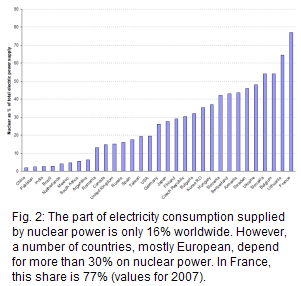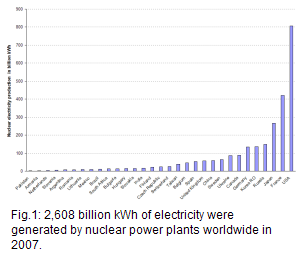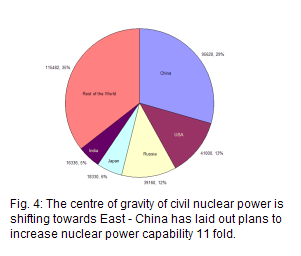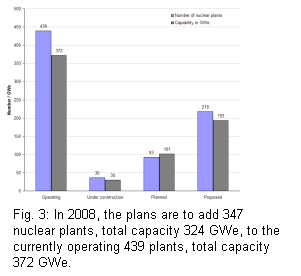
|
Insight : nuclear power |

|
|
You are here: areppim > Nature > Insight : nuclear power
Nuclear power: solution or problem?

 There are currently (June 2008) 439 nuclear plants in operation, feeding 16% of all electricity consumed worldwide (see enlarged Fig. 1 chart). Nine European countries depend on nuclear power for their electricity supply to the extent of something between 42% for Slovenia and 77% for France (see enlarged Fig. 2 chart)
There are currently (June 2008) 439 nuclear plants in operation, feeding 16% of all electricity consumed worldwide (see enlarged Fig. 1 chart). Nine European countries depend on nuclear power for their electricity supply to the extent of something between 42% for Slovenia and 77% for France (see enlarged Fig. 2 chart)
The number of shutdown reactors reaches 119, 70% of which in the USA, United Kingdom, France and Germany. Normally, a plant must shut down on average 39 days every 17 months for refuelling or maintenance. However, long-term shutdown may be dictated by technical, security or political reasons. The normal life cycle of a nuclear reactor is of 40 to 50 years. Half of the current operating plants are more than 24 years old.
After a retreat of more than a decade, the issue of nuclear power is back on the agenda. This is the result of the combined impact of stronger energy demand by the new industrialised countries, the pressure to reduce GHG (greenhouse gas) emissions, and the rising prices of oil.
The craving for power is such that the pro-nuclear sectors of the world are urging to almost double the number of currently operable units, to reach a total capability of some 700 GWe (gigawatt or billion watts of electricity output) (see enlarged Fig. 3 chart).
Some WNA (World Nuclear Association) definitions:
- Operating plant: connected to the power supply grid;
- Under construction: first concrete for reactor poured, or major refurbishment under way;
- Planned: approvals, funding or major commitment in place, mostly expected in operation within 8 years, or construction well advanced but suspended indefinitely;
- Proposed: clear intention or proposal but still without firm commitment.


Nuclear capacity has increased by more than 20,000 MW since 2000, mostly thanks to new plants in Far East. Almost two thirds of the total capabilities targeted by the future nuclear plant projects (in construction, planned and proposed) come from 5 countries led by China (see enlarged Fig. 4 chart). This nation has high ambitions, with long term objectives to build a capability eleven fold bigger than the one existing in 2008. The gravity centre of nuclear power appears to shift clearly towards East.
The issue of nuclear power is far from being a clear-cut one. Nuclear proponents promote it as the solution for the world's current energy problems. Sceptics claim that, not only nuclear power is not a solution, but it may turn out to be the source of new problems. Let us briefly review the nuclear pros and cons.
Nuclear supporters say:
- It is a much cleaner alternative than oil, natural gas or coal, emitting much less CO2 (carbon dioxide) than the latter options.
- Nuclear power is the best means to acquire independence from oil and gas producing nations that now command world energy supply. It uses a fuel - uranium - that is relatively abundant and cheap compared to oil or gas.
- Nuclear reactor efficiency is high, having increased from the past 70% to the current 80% grade.
- As the so-called "carbon tax" (calculated on the basis of equivalent CO2 emissions) will become common practice, nuclear kWh, currently significantly more expensive to produce than coal, oil or gas-powered electricity, will regain competitiveness.
- New technologies of nuclear fuel reprocessing may significantly reduce the amount of nuclear waste produced by the prevailing technologies. Nuclear fuel reprocessing, also known as uranium enrichment, consists of extracting plutonium from spent fuel and turn it into fuel for use in another plant.
- New approaches of nuclear waste management, namely the geological repository, of which the first project should become operational in Finland by 2020, will aptly solve the problem of disposal without short and long term hazards to public health and safety.
These arguments seem rather unconvincing to non-believers. Nuclear power sceptics say:
- Nuclear power may not be the answer to a carbon-free environment. In order to make a dent in the projected GHG emissions by 2050, the world would require 1 TW (terawatt, or trillion watts) of nuclear power by that date (MIT study, 2003). This means tripling global nuclear power production. Taking into account the current 372,000 MW capacity, the 40-50 year life cycle of the reactors, and the resulting need to replace the operating units now with a median age of 24 years, a simple calculation shows that the world should add roughly 2,000 MW capabilities each month in the course of the forthcoming 42 years, starting today. As a yardstick, the modern EPR (European pressurized reactor, a generation III+ reactor) under construction in Finland, has a 1,600 MW capability, is budgeted at EURO 3 billion, and should take 57 months to build from pouring the first concrete to plant commissioning – in fact it will cost a lot more, if for no other reason because it is more than 18 months behind schedule. The technical, financial and managerial burdens may prove an insurmountable obstacle in the way of the terawatt objective.
- The cost of nuclear power is currently 15% to 60% higher over life time than conventional coal or gas power (MIT study, 2003). Speculation about the possible impact of a "carbon tax" to bring the cost of nuclear power to par with alternative sources should be tempered by other developments. For instance, new technologies may revamp coal powered plants, and the burying of CO2 (being tested in Germany) may defuse the threat of the carbon tax. On the other hand, there are no reliable estimates as yet of the real cost of disposing of spent fuel and other nuclear waste, for which there is actually no solution currently. Facts say that nuclear power may be cheaper to run due to inexpensive fuels, but very expensive to build, requiring heavy capital investments, huge front-end pre-construction and on-site engineering costs, and very long waiting periods until the plant can bill the first kWh. This is why the WB (World Bank) has a long-standing policy not to lend money to nuclear projects (WB 1991).
- Nuclear power technologies are promising, but remain to be proven. Reprocessing spent fuel has been adopted by France. However, not only it entails sizable risks from complex and dangerous reprocessing, but it is also very costly. France only reprocesses 28% of yearly spent fuel. Lots of R&D, funding and time are still needed to master the process technically and economically. The so-called generation IV reactors presenting advanced features are decades away from commercial deployment.
- Nuclear power technologies, particularly the more advanced ones based on fuel reprocessing, fly in the face of political leaders concerned with nuclear proliferation in military weaponry. It is hard to reconcile militancy for the spread of new and advanced nuclear plants, with the effective prevention of the use of enriched uranium for bellicose purposes.
- Safety and health of present and future generations should command the greatest caution. Nuclear power is inherently hazardous. Needless to mention grave incidents like Three Mile Island (1979) or Chernobyl (1986). Maybe more worrisome are the hundreds of "smaller" incidents - leakages, releases of waste, short-circuits, small fires, earthquake damage, overheating, human errors, misplaced fuel, inventory delinquences, etc. - that plague the installed park of nuclear plants worldwide. Such hazards are a good reminder of the inability of all involved, maintenance technicians, security officials, process managers, plant engineers, etc. to maintain installations under tight and safe control. Considering the prevailing business environment of cost-cutting in all functions including service and maintenance, and of reliance on communication spin to sweep the dirt under the carpet, a high dose of scepticism is warranted. The facts are:
- A large plant produces 25 to 30 tons of spent fuel per year, not to mention other forms of waste, like contaminated items, materials and equipment. This amounts to 11,000 to 13,000 tons of nuclear waste per year to be added to the stockpile by the now-operating 439 plants. More reactors will generously add many thousands of tons of waste to an already cumbersome stock.
- Nuclear waste is highly radioactive, presenting both short-term radioactivity (fission products) and long-term radioactivity (mostly plutonium and curium). Radioactive decay is very slow. The concepts of short and long-term with regard to nuclear radioactivity are out of human scale. They are not measurable in months and years but in centuries and tens of thousand years.
- As of now, nuclear waste is stored somewhere, waiting for a yet unknown solution to dispose of it effectively. The process of nuclear waste disposal is vulnerable to accidents or malicious tampering. The only guarantee is that future generations will inherit a hidden wealth of dangerous radioactive materials.
- MIT - The Future of Nuclear Power, 2003, http://web.mit.edu/nuclearpower/.
- WNA - World Nuclear Association.
- IAEA - International Atomic Energy Agency.
- Scientific American, special issue on energy, Sept 2006.]
Download


 Go toTop
Go toTop
 Home
Home